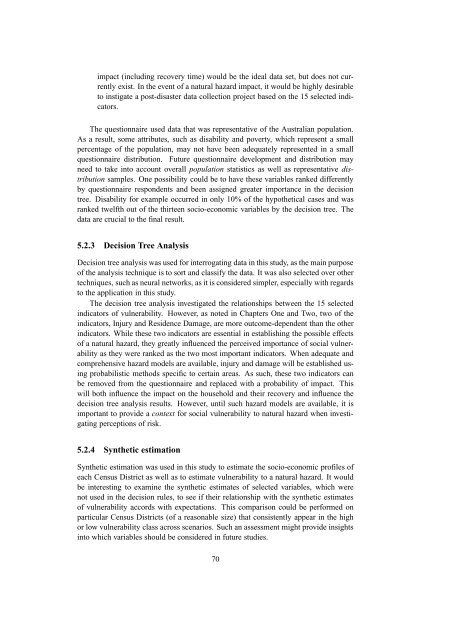Quantifying Social Vulnerability: A methodology for ... - EarthByte
Quantifying Social Vulnerability: A methodology for ... - EarthByte
Quantifying Social Vulnerability: A methodology for ... - EarthByte
You also want an ePaper? Increase the reach of your titles
YUMPU automatically turns print PDFs into web optimized ePapers that Google loves.
impact (including recovery time) would be the ideal data set, but does not currentlyexist. In the event of a natural hazard impact, it would be highly desirableto instigate a post-disaster data collection project based on the 15 selected indicators.The questionnaire used data that was representative of the Australian population.As a result, some attributes, such as disability and poverty, which represent a smallpercentage of the population, may not have been adequately represented in a smallquestionnaire distribution. Future questionnaire development and distribution mayneed to take into account overall population statistics as well as representative distributionsamples. One possibility could be to have these variables ranked differentlyby questionnaire respondents and been assigned greater importance in the decisiontree. Disability <strong>for</strong> example occurred in only 10% of the hypothetical cases and wasranked twelfth out of the thirteen socio-economic variables by the decision tree. Thedata are crucial to the final result.5.2.3 Decision Tree AnalysisDecision tree analysis was used <strong>for</strong> interrogating data in this study, as the main purposeof the analysis technique is to sort and classify the data. It was also selected over othertechniques, such as neural networks, as it is considered simpler, especially with regardsto the application in this study.The decision tree analysis investigated the relationships between the 15 selectedindicators of vulnerability. However, as noted in Chapters One and Two, two of theindicators, Injury and Residence Damage, are more outcome-dependent than the otherindicators. While these two indicators are essential in establishing the possible effectsof a natural hazard, they greatly influenced the perceived importance of social vulnerabilityas they were ranked as the two most important indicators. When adequate andcomprehensive hazard models are available, injury and damage will be established usingprobabilistic methods specific to certain areas. As such, these two indicators canbe removed from the questionnaire and replaced with a probability of impact. Thiswill both influence the impact on the household and their recovery and influence thedecision tree analysis results. However, until such hazard models are available, it isimportant to provide a context <strong>for</strong> social vulnerability to natural hazard when investigatingperceptions of risk.5.2.4 Synthetic estimationSynthetic estimation was used in this study to estimate the socio-economic profiles ofeach Census District as well as to estimate vulnerability to a natural hazard. It wouldbe interesting to examine the synthetic estimates of selected variables, which werenot used in the decision rules, to see if their relationship with the synthetic estimatesof vulnerability accords with expectations. This comparison could be per<strong>for</strong>med onparticular Census Districts (of a reasonable size) that consistently appear in the highor low vulnerability class across scenarios. Such an assessment might provide insightsinto which variables should be considered in future studies.70
















